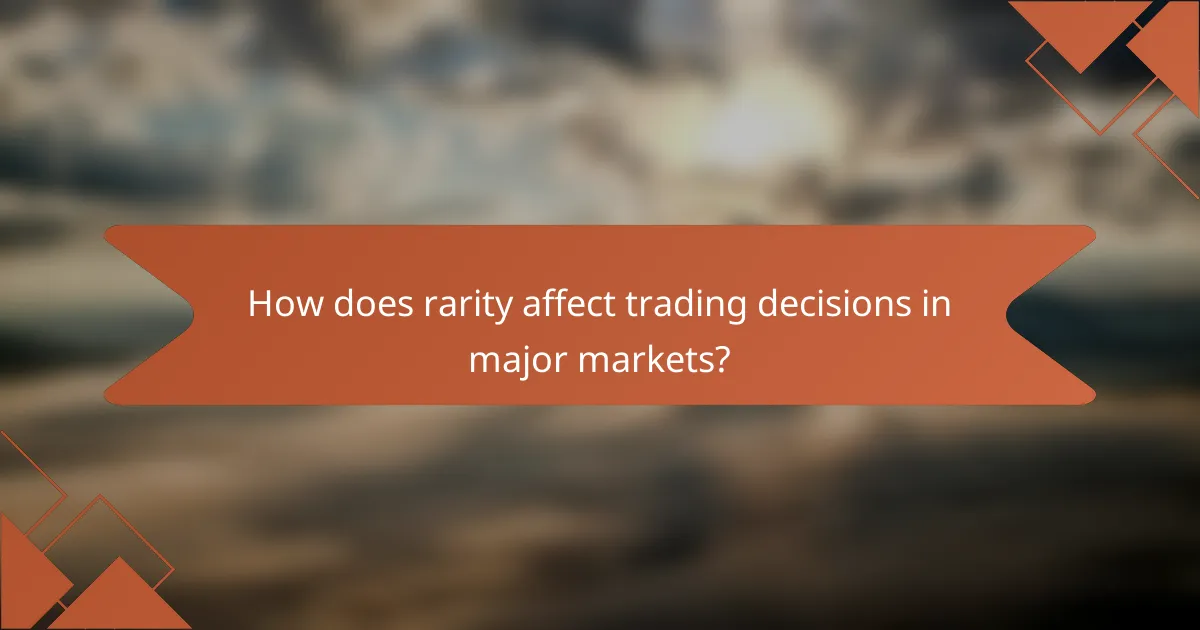Card rarity plays a crucial role in shaping trading strategies and decisions, as it directly impacts the perceived value and demand for cards in the market. Rarer cards often command higher prices, leading traders to adopt different approaches based on their scarcity and desirability. By analyzing market prices and historical sales data, traders can make informed decisions that align with the evolving trends of card rarity.

How does card rarity impact trading strategies?
Card rarity significantly influences trading strategies by affecting perceived value, demand, and investment decisions. Rarer cards typically command higher prices and can lead to different trading approaches based on their scarcity and desirability.
Increased value perception
The rarity of a card often elevates its perceived value among collectors and traders. For instance, a limited edition card may be viewed as a status symbol, leading to higher demand and prices compared to more common cards.
Traders should consider how rarity affects market sentiment. Cards that are perceived as rare can appreciate in value more quickly, making them attractive for short-term trading strategies.
Influences demand and supply
Card rarity directly impacts supply and demand dynamics in the trading market. When a card is scarce, demand typically increases, driving prices up. Conversely, if a card is widely available, its demand may decrease, leading to lower prices.
Understanding these dynamics can help traders make informed decisions. For example, monitoring the supply of a newly released card can provide insights into potential price movements and trading opportunities.
Guides investment decisions
Rarity serves as a critical factor in guiding investment decisions. Investors often prioritize rare cards as they tend to hold their value better over time compared to more common cards. This can lead to more stable returns in the long run.
When building a trading portfolio, consider including a mix of rare and common cards. This strategy can balance risk while taking advantage of the potential appreciation of rare cards, especially in fluctuating markets.

What are the different types of card rarity?
Card rarity refers to the classification of cards based on their availability and desirability within a trading card game or collectible card market. Understanding the different types of rarity can significantly influence trading strategies and decisions, as rarer cards often hold higher value and demand.
Common, Uncommon, Rare
Common cards are the most frequently found in booster packs and are usually the least valuable. Uncommon cards are less prevalent than common cards and often feature slightly better abilities or artwork, making them more sought after by collectors. Rare cards are harder to find and typically have unique features or stronger gameplay mechanics, which can drive their market value higher.
When trading, consider that common and uncommon cards can often be acquired at low costs, making them ideal for beginners. Rare cards, however, may require more investment and careful negotiation to obtain, as their scarcity can lead to price fluctuations.
Ultra Rare and Legendary
Ultra Rare cards are significantly harder to find than rare cards and often include powerful abilities or exclusive artwork. These cards can command high prices in the market, sometimes reaching hundreds or even thousands of dollars, depending on their popularity and condition. Legendary cards are the pinnacle of rarity, often limited to a few copies, and are highly coveted by collectors and players alike.
When engaging in trading, focus on the demand for ultra rare and legendary cards, as their value can appreciate rapidly. Be cautious of counterfeits, especially with high-value cards, and always verify authenticity before making a purchase or trade.

How can traders assess card rarity?
Traders can assess card rarity by analyzing market prices, scarcity metrics, and historical sales data. Understanding these factors helps in making informed trading decisions and predicting future value trends.
Market price analysis
Market price analysis involves examining the current selling prices of cards in various marketplaces. Traders should look for price trends over time to identify whether a card’s value is increasing or decreasing. For instance, a card that consistently sells for higher amounts over several months may indicate strong demand and rarity.
Utilizing platforms like eBay or specialized trading card sites can provide insights into average selling prices. Comparing listings can help traders gauge whether a card is priced fairly based on its rarity.
Scarcity metrics
Scarcity metrics refer to the quantifiable aspects of a card’s availability, such as print runs and population reports. Cards with limited print runs or those graded by professional services often have higher perceived rarity. For example, a card with only a few hundred copies in existence is typically more valuable than one with thousands.
Traders should also consider the condition of the card, as higher grades can significantly impact value. Utilizing resources like PSA or BGS population reports can help in understanding how many cards of a particular type exist in various conditions.
Historical sales data
Historical sales data provides a record of past transactions, helping traders identify patterns and price fluctuations over time. Analyzing this data can reveal how a card’s value has changed in response to market trends or events, such as tournaments or releases.
Traders can access historical sales data through auction sites or trading platforms. Keeping track of sales for similar cards can also aid in forecasting future prices, allowing traders to make better decisions when buying or selling rare cards.

What strategies can be employed based on card rarity?
Card rarity significantly influences trading strategies, as it determines both the potential value and demand for cards. Understanding how to leverage rarity can lead to more informed buying and selling decisions.
Long-term investment strategies
Investing in rare cards can yield substantial returns over time, especially if the card’s value appreciates due to increased demand or scarcity. Focus on high-grade cards from popular sets or those tied to significant events in gaming history.
Consider holding onto cards that are graded by reputable organizations, as these often maintain or increase their value. For instance, a rare card in mint condition can appreciate by tens of percent annually, depending on market trends.
Short-term flipping tactics
Flipping cards involves buying low and selling high within a short timeframe, capitalizing on market fluctuations. Rare cards that are trending or have recently gained popularity can be excellent candidates for this strategy.
Monitor online marketplaces and auction sites for sudden spikes in demand. Setting alerts for specific cards can help you act quickly when prices rise, allowing for profitable sales within days or weeks.
Diversification of card portfolio
Diversifying your card portfolio by including a mix of common and rare cards can mitigate risk. While rare cards may appreciate, common cards can provide liquidity and quick sales when needed.
Consider allocating a percentage of your budget to various rarity levels. For example, you might invest 70% in rare cards and 30% in common or mid-tier cards to balance potential high returns with stable cash flow.

How does rarity affect trading decisions in major markets?
Rarity significantly influences trading decisions by determining a card’s perceived value and demand. Traders often prioritize rare cards, as their limited availability can lead to higher prices and more competitive trading opportunities.
Regional demand variations
Demand for rare cards can vary widely across different regions. In markets where collectors are more active, such as North America and Europe, rare cards often fetch higher prices due to increased competition among buyers. Conversely, in regions with less interest in card collecting, the same cards may not hold as much value.
Understanding local preferences is crucial. For example, certain card types may be more popular in specific areas, affecting their rarity and demand. Traders should research regional trends to make informed decisions.
Market trends in North America
In North America, the market for rare cards has seen significant growth, driven by a surge in interest from both collectors and investors. High-profile sales of rare cards at auctions have set benchmarks, influencing trading strategies across the board.
Traders in North America should monitor trends such as the rise of digital collectibles and the impact of social media on card valuation. Engaging with online communities can provide insights into which rare cards are gaining traction and may be worth investing in.

What tools can help in evaluating card rarity?
Evaluating card rarity is essential for making informed trading decisions. Various tools can assist in this process, helping collectors and traders assess the value and demand for specific cards.
Price tracking platforms
Price tracking platforms provide real-time data on card values, allowing users to monitor fluctuations in the market. These platforms typically aggregate sales data from various sources, offering insights into trends and average prices.
Popular platforms include TCGPlayer, CardMarket, and eBay. Users can set alerts for specific cards to receive notifications when prices change significantly, helping them make timely trading decisions.
Card grading services
Card grading services evaluate the condition and authenticity of cards, assigning them a grade that can significantly influence their market value. Well-known grading companies like PSA, BGS, and SGC provide standardized grading scales, which help establish a card’s rarity and desirability.
When considering grading, it’s important to factor in the cost of the service and the potential increase in value. A high-grade card can fetch several times more than a lower-grade counterpart, making grading a worthwhile investment for valuable cards.
Market analysis software
Market analysis software offers advanced tools for tracking and analyzing card trends over time. These programs can provide insights into historical price movements, demand metrics, and comparative analysis across different card sets.
Using market analysis software can help traders identify undervalued cards or emerging trends. Tools like Market Movers and Card Ladder allow users to create custom dashboards and reports, enhancing their trading strategies based on data-driven insights.

What are the risks associated with trading rare cards?
Trading rare cards carries several risks, including market fluctuations, potential for counterfeit items, and liquidity challenges. Understanding these risks is crucial for making informed trading decisions.
Market volatility
Market volatility refers to the rapid price changes that can occur in the trading of rare cards. Prices can fluctuate significantly based on demand, trends, and external factors like economic conditions or popular culture influences.
For example, a rare card might sell for hundreds of dollars one month and drop to a fraction of that price the next month due to a sudden change in collector interest. It’s essential to monitor market trends and be aware of seasonal fluctuations that can impact card values.
To mitigate risks associated with market volatility, consider diversifying your collection and setting a budget for trading. Avoid making impulsive decisions based solely on short-term price changes.
